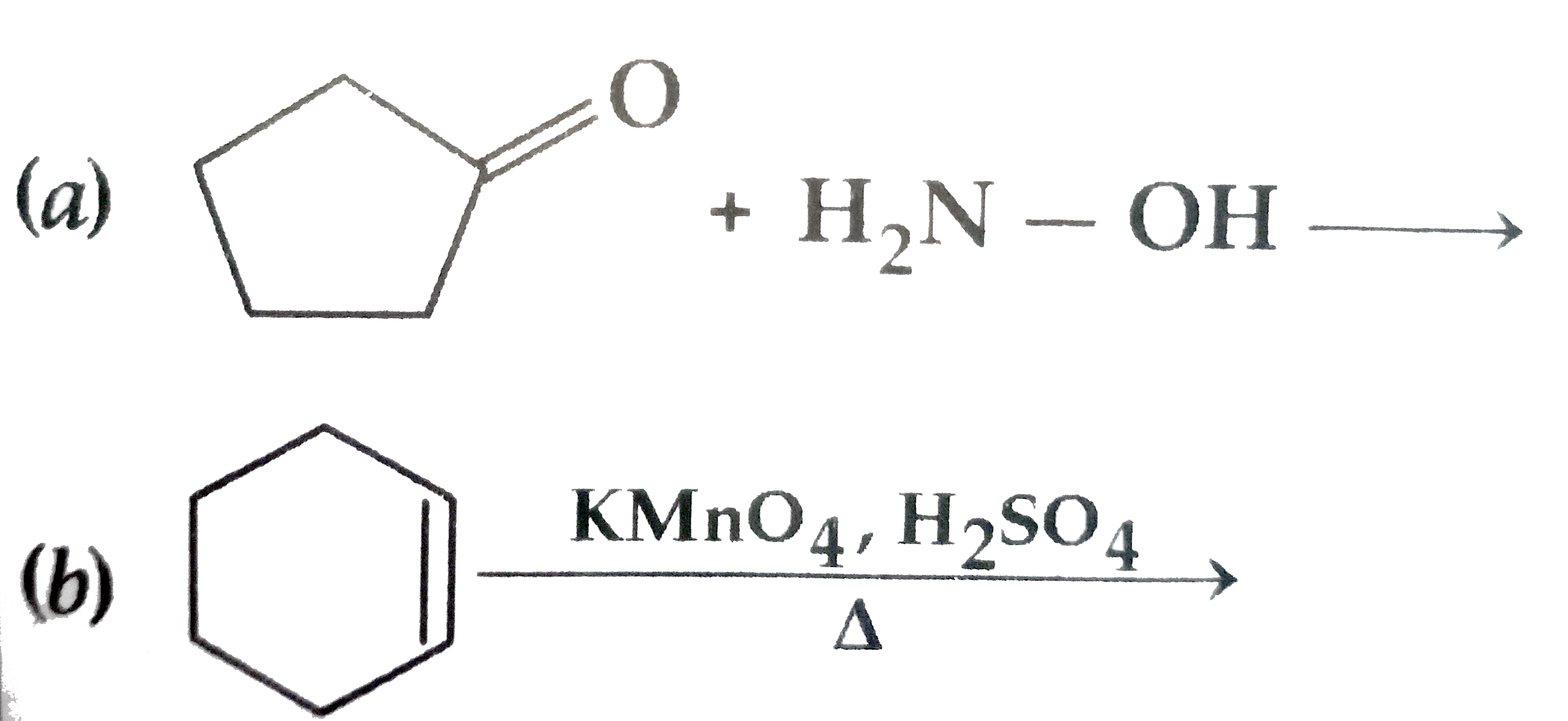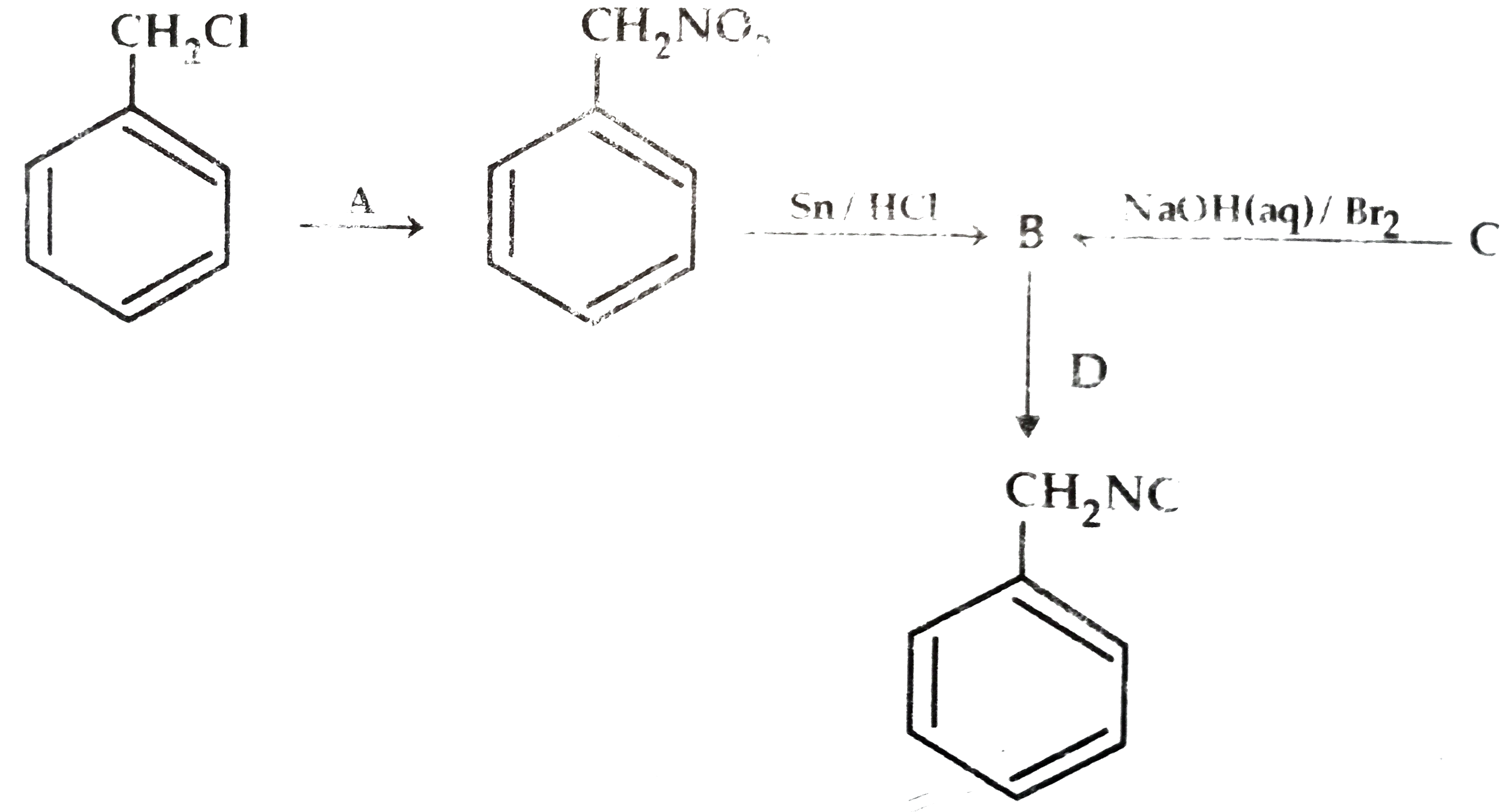Complete Solutions to QUESTION PAPER (SECTION-C) of chapter XII BOARDS of Class 12 book with complete answers and questions
| Class 12 | CHEMISTRY |
| Chapter | XII BOARDS |
| XII BOARDS PREVIOUS YEAR | QUESTION PAPER (SECTION-C) |
| Number Of Questions | 22 |
| Academic Year | 2023-24 |
Niobium crystallises in body-centred cubic structure. If the atomic radius is 143.1 pm, calculate the density of Niobium. (Atomic mass = 93u).
View SolutionGive reasons for the following :
(a) When 2g of benzoic acid is dissolved in 25 g of benzene, the experimentally determined molar mass is always greater than the true value.
(b) Mixture of ethanol and acetone shows positive deviation from Raoult's Law.
(c) The preservation of fruits by adding concentrated sugar solution protects against bacterial action.
View SolutionAn alcohol [A] with molecules formula `(C_(4)H_(10)O)` o oxidation with aciddified potassium dichromate gives acid [B] `(C_(4)H_(8)O_(2))`. Compound [A] when dehydrated with conc. `H_(2)SO_(4)` at `443 K` gives compound [C]. Treatment of [C] with aqueous `H_(2)SO_(4)` gives compound [D] `(C_(4)H_(10)O)` which is an isomer of [A]. compound [D] is resistant to oxidation but compound [A]can be easily oxidised. Identify [A], [B], [C] and [D]. Name the type of isomerism exhibited by [A] and [D].
View SolutionWhich on of the following compounds will undergo faster hydrolysis reaction by `S_(N)1` mechanism ? Justify your answer.

View SolutionA compound is formed by the substitution of two chlorine atoms for two hydrogen atoms in propane. Write the structures of the isomers possible.
Give the IUPAC name of the isomer which can exhibit enantiomerism.
View SolutionComplete the following reactions :


View SolutionGive reasons for the following :
(i) Use of aspartame as an artificial sweetener is limited to cold foods.
(ii) Metal hydroxides are better alternatives than sodiumk hydrogen carbonate for treatment of acidity.
(iii) Aspirin is used in prevention of heart attacks.
View Solution(a) Name the branched chain component of starch.
(b) Ribose in RNA and deoxyribose in DNA differ in the strucute around which carbon atom ?
(c ) How many peptide linkages are present in a tripeptide ?
View SolutionGive three reactions of glucose which cannot be explained by its open chain structure.
View SolutionThe following data were obtained during the first order thermal decomposition of `N_(2)O_(5)` (g) at constant volume :
`2N_(2) O_(5)(g)to 2N_(2)O_(4)(g) +O_(2)(g)`

Calculate the rate constnat.
View SolutionTwo reactions of the same order have equal pre exponential factors but their activation energies differ by 24.9kJ `"mol"^(-1)`. Calculate the ratio between the rate constants of these reactions at `27^(@)C`. (Gas constant R = 8.314 J `K^(-1) "mol"^(-1)`)
View Solution(a) A colloidal sol is prepared by the given method in figure. What is the charge of AgI colloidal particles in the test tube ? How is the sol formed, represented?
 (b) Explain how the phenomenon of adsorption finds application in Heterogeneous catalysis.
(b) Explain how the phenomenon of adsorption finds application in Heterogeneous catalysis.
(c) Which of the following electroytes is the most effective for the coagulation of `Fe(OH)_(3)` sol which is a positively charged sol?
`NaCI, Na_(2)SO_(4), Na_(3)PO_(4)`
View SolutionDescribe how the following steps can be carried out?
(a) Recovery of Gold from leached gold metal complex.
(b) Conversion of Zirconium iodide to pure Zirconium.
(c) Formation of slag in the extraction of copper.
(Write the chemical equations also for the reactions involved)
View SolutionExplain the use of the following : (a) NaCN in Froth Floatation Method.
(b) Carbon monoxide in Mond process.
(c) Coke in the extraction of Zinc from Zinc Oxide
View SolutionExplain the following :
(a) Out of `Sc^(3+), Co^(2+) " and "Cr^(3+) "ions, only "Sc^(3+)` is colourless in aqueous solutions. (Atomic no.: Co =27, Sc = 21 and Cr =24)
(b) The `E^(@)Cu^(2+)//Cu` for copper metal is positive (+0.34), unlike the remaining members of the first transition series.
(c) `La(OH)_(3) " is more basic than Lu "(OH)_(3).`
View SolutionA metal complex having composition `Cr(NH_(3))_(4)CI_(2)Br` has been isolated in two forms A and B. The form A reacts with `AgNO_(3)` to give a white precipitate readily soluble in dilute aqueous ammonia whereas B gives a pale yellow precipitate soluble in concentrated ammonia.
(i) Write the formulae of isomers A and B.
(ii) State the hybridisation of chromium in each of them.
(iii) Calculate the magnetic moment (spin only) of the isomer A.
View Solution(a) Identify A-D
(b) Distinguish between the following pair of compounds :
(i) Aniline and Benzylamine.

(ii) Methylamine and Dimethylamine
(c) Complete the following :
`CH_(3)CH_(2)CN overset(LiAIH_(4))(to) A overset(0^(@)C//HNO_(2))to B`
View Solution(a) Account for the following :
(i) Direct nitration of aniline yields significant amount of meta derivative.
(ii) Primary aromatic cannot be prepared by Gabriel phthalimide synthesis.
(b) Carry out the following conversions :
(i) Ethanoic acid into methanamine.
(ii) Aniline to p-Bromoniline.
(c) Arrange the following in increasing order of basic strength :
Aniline, p-nitroaniline and p-toludine.
View Solution(a) A cell is prepared by dipping a zinc rod in 1M zinc sulphate solution and a silver electrode in 1M silver nitrate solution. The standard electrode potential given :
`E^(@)Zn_(2+1//Zn) = -0.76V, E^(@)A_(g+//)A_(g) = +0.80V`
What is the effect of increase in concentration of `Zn^(2+) " on the " E_(cell)` ?
(b) Write the products of electrolysis of aqueous solution of NaCI with platinum electrodes.
(c) Calculate e.m.f. of the following cell at 298 K:
`"Ni(s)"//"Ni"^(2+)(0.01M)////"Cu"^(2+)(0.1M)//"Cu(s)"`
`["Given"E_(Ni2+//Ni)^(@) = -0.025 V E_(Cu2+//Cu)^(@) = +0.34V]`
Write the overall cell reaction.
View Solution(a) Apply Kohlrausch law of independent migration of ions, write the expression to determine the limiting molar conductivity of calcium chloride.
(b) Given are the conductivity and molar conductivity of NaCI solutions at 298 K at different concentrations :

Compare the variation of conductivity and molar conductivity of NaCI solutions on dilution. Give reason.
(c) 0.1 M KCI solution offered a resistance of 100 ohms in conductivity cell at 298 K. If the cell constant of the cell is `1.29 cm^(-1)`, calculate the molar conductivity of KCI solution.
View Solution(a) Account for the following observations :
(i) `SF_(1)` is easily hydrolysed whereas `SF_(6)` is not easily hydrolysed.
(ii) Chlorine water is a powerful bleaching agent.
(iii) Bi (V) is a stronger oxidising agent than Sb(V)
(b) What happens when :
(i) White phosphorus is heated with concentrated NaOH solution in an inert atmosphere of `CO_(2).`
(ii) `XeF_(6)` undergoes partial hydrolysis.
(Give the chemical equations involved).
View Solution(a) What inspired N.Bartlett for carrying out reaction between Xe and `PtF_(6)` ?
(b) Arrange the following in the order of property indicated against each set :
(i) `F_(2), I_(2), Br_(2), CI_(2)` (increasing bond dissociation enthalpy)
(ii) `NH_(3), AsH_(3), SbH_(3), BiH_(3), PH_(3)` (decreasing base strength)
(c) Complete the following equations :
(i) `CI_(2) + NaOH ("cold and dilute") to`
(ii) `Fe^(3+) SO_(2) + H_(2)O to`
View Solution
QUESTION PAPER (SECTION-C) questions and complete solutions for chapter XII BOARDS of XII BOARDS PREVIOUS YEAR of Class 12
All Exercises from XII BOARDS PREVIOUS YEAR Class 12 CHEMISTRY XII BOARDS
- C.B.S.E CLASS XII
- C.B.S.E CLASS XII
- C.B.S.E. CLASS - XII
- C.B.S.E. CLASS - XII
- C.B.S.E. CLASS-XII
- C.B.S.E. CLASS-XII
- CHEMISTRY (THEORY)
- CHEMISTRY (THEORY)
- CHEMISTRY (Theory) [SET - I]
- CHEMISTRY (Theory) [SET - I]
- Delhi Board : Set - II
- Delhi Board : Set - II
- Delhi Board : Set - III
- Delhi Board : Set - III
- DELHI BOARD SET II
- DELHI BOARD SET II
- General Instrucations
- General Instrucations
- IMPORTANT QUESTIONS FOR PRACTICE CHEMISTRY (THEORY-XII) UNSOLVED)
- IMPORTANT QUESTIONS FOR PRACTICE CHEMISTRY (THEORY-XII) UNSOLVED)
- OUTSIDE DELHI (SET-I)
- OUTSIDE DELHI (SET-I)
- Outside Delhi : SET-I
- Outside Delhi : SET-I
- Outside Delhi : SET-II
- Outside Delhi : SET-II
- Outside Delhi : SET-III
- Outside Delhi : SET-III
- Outside Delhi : SET-II
- Outside Delhi : SET-II
- Outside Delhi : SET-III
- Outside Delhi : SET-III
- Outside Delhi Board: Set-III
- Outside Delhi Board: Set-III
- Outside Delhi: Set-II
- Outside Delhi: Set-II
- QUESTION PAPER (SECTION-A)
- QUESTION PAPER (SECTION-A)
- QUESTION PAPER (SECTION-B)
- QUESTION PAPER (SECTION-B)
- QUESTION PAPER (SECTION-C)
- QUESTION PAPER (SECTION-C)
- Questions
- Questions
- SECTION-A
- SECTION-A
- SECTION-B
- SECTION-B
- SECTION-C
- SECTION-C
- SECTION-D
- SECTION-D
- Set - 1 Comptt.
- Set - 1 Comptt.
- SET - II
- SET - II
- Set -I
- Set -I
- Set -II
- Set -II
- Set -III
- Set -III
- Set I
- Set I
- Set II
- Set II
- Set III
- Set III
- SET- I
- SET- I
- SET- II
- SET- II
- SET- III
- SET- III
- SET-1
- SET-1
- SET-I
- SET-I
- SET-II
- SET-II
- SET-III
- SET-III
- [OUTSIDE DELHI : SET - III]
- [OUTSIDE DELHI : SET - III]
- [OUTSIDE DELHI : SET - II]
- [OUTSIDE DELHI : SET - II]
- [OUTSIDE DELHI : SET -III]
- [OUTSIDE DELHI : SET -III]
- [OUTSIDE DELHI : SET -II]
- [OUTSIDE DELHI : SET -II]
- [SET-1]
- [SET-1]
- [SET-III]
- [SET-III]
- [SET-II]
- [SET-II]
- [SET-I]
- [SET-I]